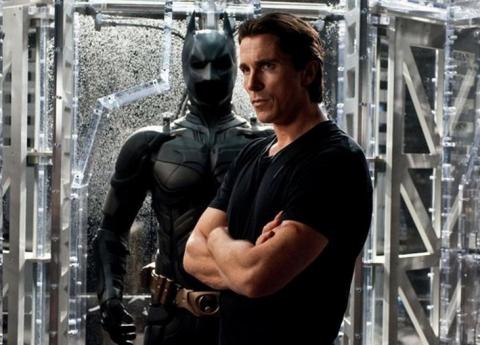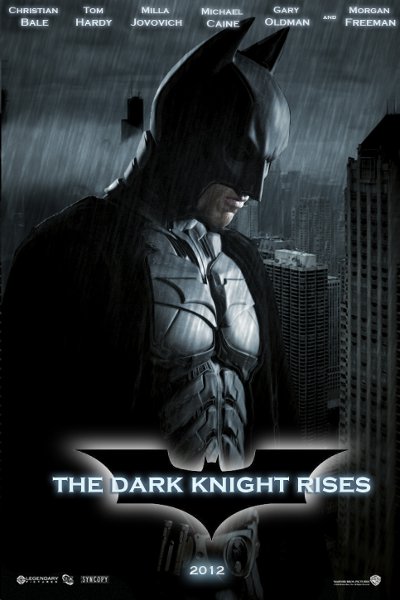The Dark Knight and the Rise of ‘Realistic’ Superheroes on Screen

Batman has been stuck in the same cycle for 70 years. As soon as the “Dark Knight’s” mythology becomes too dark, he is reinterpreted through the faddish lens of pop cultural parody. Consequently, Batman’s legend lacks substance. So he’s reinterpreted once again with darker shadings. But “The Dark Knight Rises,” the final chapter in Christopher Nolan’s epic addition to the Batman myth, looks past both interpretations. As Nolan promised us from the beginning, his trilogy offers a realistic superhero. But can there really be such a thing? Should there be?
Batman’s original creator, Bob Kane, drew inspiration from a sketch by Leonardo da Vinci of a glider with bat-like wings and the swashbuckling hero played by Douglas Fairbanks in 1920’s “The Mark of Zorro.” Kane blended Da Vinci’s adventurous imagination with Fairbanks’ matinee idol charm to construct a darker hero named Batman — a playboy-turned-vigilante, driven by the demons of revenge, determined to strike fear in the hearts of all criminals.
By the 1950s, Batman, like other caped crusaders during the Eisenhower era, was forced to fight aliens and endure the embarrassment of sci-fi-inspired sidekicks like the Bat-Ape and Ace the Bat-Hound. It wasn’t long before Kane’s brooding superhero was transplanted into a campy TV series. This was the spirit of the first “Batman” film in 1966. Tim Burton’s “Batman” spent 10 years in developmental purgatory before reaching the screen in 1989. The sequel, “Batman Returns” (1992), was so disturbing that the franchise was handed over to Joel Schumacher, who opted for the studio-sanctioned, safer, more satirical interpretation. “Batman Forever” (1995) was a box-office smash and sold a ton of toys, but the fourth installment, “Batman and Robin” (1997), was a fiasco that resulted in nearly a dozen Razzie Award nominations.
After lengthy discussions about how to repackage Batman once again, it was ultimately decided that he needed to be rebooted as the Dark Knight. It could be dark, but not black; violent, but not bloody; scary, but not terrifying. Nolan and his collaborators, screenwriters David S. Goyer and Jonathan Nolan, attempted to achieve this middle-of-the-road goal by bathing Batman in realism and “humanity,” an industry code word meaning everything-is-explained.
The trilogy, with a total running time of seven-and-a-half-hours, has absolutely no trace of parody or camp. There’s not even a directorial sense of humor. One could argue that the series is “dark,” but it doesn’t approach the twisted uneasiness induced by the gory, haunted endings of Burton’s two films. Nolan has a realistic notion of Batman. “The world of Batman is that of grounded reality,” he told Variety in 2004. “Ours will be a recognizable, contemporary reality against which an extraordinary heroic figure arises.”
Even though “Batman Begins” (2005) is somewhat bogus, and, like Nolan’s “Inception” (2010), unnecessarily complicated, it zips along quickly enough to keep you engaged. In that film, Batman fights to stop Ra’s Al Ghul, a madman who wants to destroy Gotham City because, he says, “the city has become a breeding ground for suffering and injustice. It is beyond saving and must be allowed to die.” Batman successfully defeats the bad man (or does he?) and effectively shreds the city into concrete rubble, no doubt killing who-knows-how-many civilians along the way.
In “The Dark Knight” (2008), Batman battles the Joker, who, unlike Batman’s last nemesis, has no purpose other than to incite panic, chaos, and fear. The notion being kicked around in the second film is that Batman is just as much of a terrorist as the Joker. This idea is revisited again (and again) in “The Dark Knight Rises,” a puzzlingly unimaginative movie composed of dense two-person scenes and a half-dozen action sequences. Batman’s enemy here is Bane, a hulking but erudite villain with the metallic legs of a snow crab obscuring his mouth, and making a good many of his words impossible to hear. No matter. You get the idea: He’s a nihilistic, anarchistic, dictatorial, power-hungry brute. But he’s also given a painful backstory, suggesting perhaps (as the Joker’s presence suggested in “The Dark Knight”) that Bane and Batman are two nut-jobs cut from the same cloth. They both have their own extreme ideas about how to administer justice.
But this Batman is only as dark as reality will allow. And for all the supposed darkness in Nolan’s trilogy, there’s a plodding sameness that strips the Dark Knight of his power as a modern pop antihero. The saga suffers from a kind of literal-minded, self-defeating realism that feels wrong for a figure like Batman. The dialogue is packed with plenty of philosophical sputterings on higher themes, but the filmmakers seem resistant to the kind of fantastical excitement that makes comic books come to life. The whole story is so firmly grounded that it never takes off; it doesn’t soar. Some of the action sequences reach toward the extraordinary — like the airplane stunt at the beginning of “The Dark Knight Rises” — but these loud explosions of special effects do little to excite. Nolan’s take on the Batman myth is stubbornly realistic. It’s as if he thinks that the only way to achieve terror onscreen is to show the blunt-witted acts of a terrorist.
Within this prison of realism, he denies any possibility of comic buoyancy. The word comic implies not only that which causes laughter and also a comic book sensibility. The comic book is, after the mystery story, musical comedy, and jazz, one of the very few uniquely American art forms. The most distinctive aspect of these art forms is that they provide an undeniable thrill, a stimulating burst of joy. The difference between the comic book Batman and Christopher Nolan’s Batman is the difference between excitement and dread.

The landscape of Gotham City is so realistic you find yourself weighed down by a sense of aforementioned dread. The irony of this is that reality is abandoned completely whenever the filmmakers feel it’s necessary. After all, there’s almost nothing realistic about the Batman story — that’s why it’s fun, that’s why it’s exhilarating, that’s why it will endure as pop mythology.
But in a bid for realism, the filmmakers deny Batman all of his Batman-ness, so to speak. In “Dark Knight Rises,” this is literally true. Christian Bale, a fine actor when he’s not encased in the stoic mask of Bruce Wayne, or impeded by his you-can’t-be-serious raspy Batman voice, spends the majority of this film too feeble to walk. He goes from being a recluse in a bathrobe to a partially disabled prisoner.
Can a movie be realistic but implausible? Before the conclusion to Nolan’s trilogy, I wasn’t sure. The stale exchanges between the characters are banal enough to be realistic, but they fail to convince. Maybe I (wrongfully) expect a touch of humor and lightness in a movie about a superhero — yes, even a superhero like Batman. The Dark Knight’s armor loses something of its luster when his revenge-driven desire for justice is reduced to a ho-hum observation that no one is capable of administering justice in the real world. This “reading” of Batman seems pointlessly academic.
That’s why the “The Dark Knight Rises” is so stiff and dutiful and solemn: The filmmakers are, on some level, determined to make some vaguely topical statement that’s actually more of an elliptical mentioning than a statement. Batman makes several War on Terror-type moves throughout the saga; Bane speaks about the people taking back their city from the rich, invoking scenes that invoke everything from the French Revolution to the Occupy Wall Street movement. None of these political allusions come to anything, other than to serve the tired function of grounding the movie in reality.
When it comes to the pure mirth provided by good ol’ fashioned popular entertainment, “The Dark Knight Rises” offers a mirror instead of a rabbit hole. We want our legends to carry us off into another realm. The latest Batman legend carries the hero into our world, and then tries to convince us that a man who takes the law into his own hands would present a problem in reality. But we already know that. That’s why the escapism of the comic superhero is so electrifying and renewing. That’s why superhero movies will always have an audience. Even superhero movies as dreary as “The Dark Knight Rises.”
The catastrophe that occurred in Aurora, Colorado has sparked the same awkward, queasy questions that violent movies have been raising since “Bonnie and Clyde.” How much influence does the moving image have upon the mind? We’ll never know. All we know is that a very sick individual used the opportunity of a midnight movie premiere to unleash a premeditated act of carnage that would keep his name in the media for weeks, maybe months.
But his carnage backfired to a large extent because it was met with acts of true heroism by theatergoers like Allie Young , and Stephanie Davies. In a speech on Sunday, President Obama spoke of their courageousness in the midst of terror. In the middle of a disaster, average citizens acted heroically, selflessly. Heroes do appear in reality, but the reality we live in is very different from the reality created onscreen.
Author Bio:
Christopher Karr is a contributing writer at Highbrow Magazine.





























































































































































































































































































































